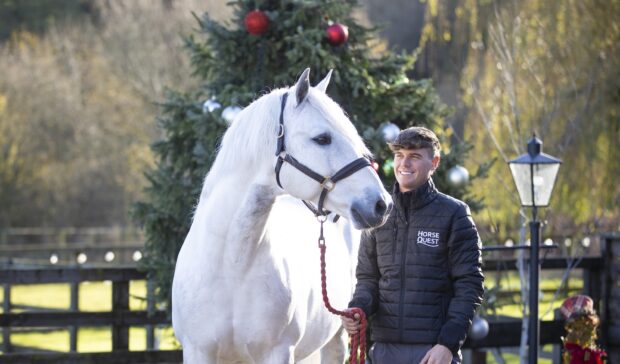The owner of a horse who became seriously ill with atypical myopathy after grazing in a field with sycamore trees wants to raise awareness of the condition.
Viki Lees Martin of Newhaven in East Sussex moved her 19-year-old gelding Burt and seven-year-old mare Armida into a paddock edged with sycamore trees on 30 April. A week later she noticed Burt was unwell.
Vikki told H&H: “When I went to bring them in the following Wednesday (8 May) Burt looked lifeless – he was like a zombie.
“He was very underneath himself at his back end and looked uncomfortable. At first I thought it was colic and phoned the vet. I took his rug off and he had muscle tremors, his breathing and heart were racing.”
Viki’s vet attended and treated Burt for colic.
“When I checked him again at 11pm he looked more comfortable, but the next morning he wasn’t happy. I turned him out as he looked uncomfortable in the stable, but he just stood in the field shaking his head,” said Viki.
“I noticed I hadn’t seen him wee which I thought was quite a big thing. Another vet came out and took bloods and we discussed it being either grass sickness or atypical myopathy – I fell apart.”
Burt was taken to Cliffe Equine hospital in East Sussex, where he was put on a drip to get some fluids in to his body. A urine sample, which was dark brown, gave the vets a high suspicion of atypical myopathy and this was confirmed by blood test.
“Since then he has had 100 litres of fluids and pain relief. He’s very lucky we brought him in when we did,” Viki said.
“Burt is getting brighter every day and the vets are quietly positive. His muscle enzyme levels are getting better and he should get home this weekend. The vets are speaking about taking him off the drip and introducing turnout. We won’t know the full extent of the damage but his major organs seem ok.”
Viki had Armida blood-tested, but she has not shown any symptoms or been unwell. She now wants others to be aware of atypical myopathy and said previously she had thought of the warnings as “scaremongering”.
“I’d seen people online mention to be wary of sycamores and I didn’t really take that on board – you don’t think it will be your horse. I’ve had horses a long time and I’ve been beating myself up about it and feel like I was complacent. I have put a post on Facebook about what happened and I’ve heard good and bad stories. I think we all need to be more aware and check what’s in our fields,” said Viki.
“It can be a lottery for owners – Burt was ill, but Armida wasn’t. Fields often have mixed foliage so how do you eradicate the problem? I know you can pick up the seeds, but you can’t always cut every tree down. It can be the luck of the draw and I think Burt got the short straw that day but I can only be thinking positively now that he is on the road to recovery.”
Owners concerned about atypical myopathy can test plant samples and horse serum levels for the toxin found in sycamores, hypoglcyin A, through the Royal Veterinary College (RVC).
RVC professor of comparative neuromuscular disease Richard Piercy told H&H: “Our evidence suggests that toxin levels fluctuate in sycamore material, but as yet we do not know why. Our data and that of others also suggests that other common acer species trees in European pastures do not produce the toxin, so providing this confirmation for some horse owners who are not sure about the tree species is very reassuring. Many horse owners make a decision and resort to felling trees, so being certain about whether a tree is a possible risk for their horses is very important for many people.”
Continued below…

Atypical myopathy: what you need to know right now to keep your horses safe

‘Don’t let it be your horse’: atypical myopathy warning after racehorse dies
Owners are being urged to check their fields for sycamore seedlings now as the often-fatal condition can affect horses in

Subscribe to Horse & Hound magazine today – and enjoy unlimited website access all year round
Professor Piercy continues: “By testing horses for serum levels of the toxin, or its main metabolite, we can provide an accurate and rapid diagnosis. This allows appropriate preventative measures to be instituted, including avoidance measures for other horses on the same pastures. Negative results are also useful as they can redirect diagnostic investigation to other possible causes.”
Professor Piercy recommends owners take the following precautionary steps:
- If possible, remove horses from contaminated pastures
- Mow and remove cuttings from areas with seedlings
- Fence off areas with large numbers of seeds or seedlings
- Bring horses in at night if they are grazing sycamore-contaminated pastures
- Feed hay/haylage from reputable sources
- Consider testing horses for possible exposure if they might have been exposed and if they exhibit signs of lethargy, colic, weakness or muscle trembling – even if these signs seem mild. This should be done in consultation with your vet.
- Horses that have or might have been exposed, likely will benefit from B vitamin supplementation and other treatments. This should be done in consultation with your vet.
For all the latest news analysis, competition reports, interviews, features and much more, don’t miss Horse & Hound magazine, on sale every Thursday.




